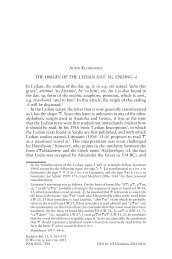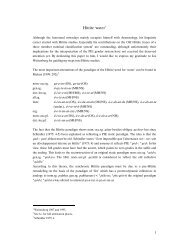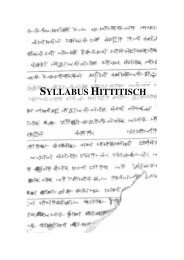The signs TA and DA in Old Hittite: evidence for a ... - Alwin Kloekhorst
The signs TA and DA in Old Hittite: evidence for a ... - Alwin Kloekhorst
The signs TA and DA in Old Hittite: evidence for a ... - Alwin Kloekhorst
- No tags were found...
You also want an ePaper? Increase the reach of your titles
YUMPU automatically turns print PDFs into web optimized ePapers that Google loves.
140Alw<strong>in</strong> <strong>Kloekhorst</strong>,<strong>The</strong> Signs <strong>TA</strong> <strong>and</strong> <strong>DA</strong> <strong>in</strong> <strong>Old</strong> <strong>Hittite</strong>spelled with the sign <strong>TA</strong> only, which conta<strong>in</strong> the sound [t]. I there<strong>for</strong>e assume that <strong>in</strong> thecase of -VTa(-), the spell<strong>in</strong>g both with <strong>TA</strong> <strong>and</strong> with <strong>DA</strong> <strong>in</strong>dicates the presence of a voicedstop, [d], too. As I have stated above as well, to my m<strong>in</strong>d the basic <strong>for</strong>m of the lenis dentalstop (which is the outcome of PIE *d <strong>and</strong> *d h <strong>and</strong> of *t when st<strong>and</strong><strong>in</strong>g <strong>in</strong> a lenit<strong>in</strong>g position)is a short voiceless stop, [t].Yet, it seems unproblematic to me to assume that <strong>in</strong> <strong>in</strong>tervocalicposition this sound was allophonically voiced to [d]. <strong>The</strong> fact that the voic<strong>in</strong>g was noncontrastiveexpla<strong>in</strong>s why the voic<strong>in</strong>g was not systematically <strong>in</strong>dicated <strong>in</strong> spell<strong>in</strong>g.ConclusionsIn <strong>Old</strong> <strong>Hittite</strong> texts, the <strong>signs</strong> <strong>TA</strong> <strong>and</strong> <strong>DA</strong> occur <strong>in</strong> word-<strong>in</strong>ternal position <strong>in</strong> such specificdistributional patterns that we cannot conclude but that they must have represented differentsounds.<strong>The</strong> exact <strong>in</strong>terpretation of the phonetic dist<strong>in</strong>ction differs per environment.In the case of <strong>in</strong>tervocalic gem<strong>in</strong>ates, the spell<strong>in</strong>g (-)Vt-ta(-) represents the presence of avoiceless gem<strong>in</strong>ate stop, [-tt-], which is the outcome of PIE *-t-, whereas the spell<strong>in</strong>g(-)Vd-da(-) represents the presence of a glottalized gem<strong>in</strong>ate stop, [-tt / -], the outcomeof the PIE cluster *-TH-. After an n, consistent use of the sign <strong>TA</strong>, °n-ta(-), represents thepresence of a cluster conta<strong>in</strong><strong>in</strong>g a voiceless stop, [-nt-], the outcome of PIE *-nd- (throughearlier *[-n $ t-]); consistent use of the sign <strong>DA</strong>, °n-da(-), represents the presence of a clusterconta<strong>in</strong><strong>in</strong>g a glottalized stop, [-nt $ -], the outcome of PIE *-nTH-; whereas <strong>in</strong>terchange betweenthe <strong>signs</strong> <strong>TA</strong> <strong>and</strong> <strong>DA</strong>, °n-ta/da(-), represents the presence of a cluster conta<strong>in</strong><strong>in</strong>g avoiced stop, [-nd-], the outcome of PIE *-nt- <strong>and</strong> *-nd h -. In the case of <strong>in</strong>tervocalic s<strong>in</strong>gletons,the <strong>in</strong>terchange between <strong>TA</strong> <strong>and</strong> <strong>DA</strong>, °V-ta/da(-), represents the presence of a voicedstop, [-d-], the outcome of PIE <strong>in</strong>tervocalic *d <strong>and</strong> *d h <strong>and</strong> of *t when st<strong>and</strong><strong>in</strong>g <strong>in</strong> lenit<strong>in</strong>gposition.<strong>The</strong> fact that the sign <strong>DA</strong> can be used <strong>in</strong> two different values, namely as [t $ a], with a glottalizedstop, <strong>and</strong> as [da], with a voiced stop, <strong>and</strong> thus differs from the sign <strong>TA</strong>, which is used<strong>in</strong> the value [ta], with a voiceless stop, perfectly fits the use of the sign <strong>DA</strong> as both ṭa(= [t / a]) <strong>and</strong> da (= [da]) <strong>and</strong> of the sign <strong>TA</strong> as ta (= [ta]) as attested <strong>in</strong> the <strong>Old</strong> Babyloniantexts from Alalah˘.<strong>The</strong> <strong>Hittite</strong> values of these <strong>signs</strong> can there<strong>for</strong>e be seen as a direct cont<strong>in</strong>uationof their values <strong>in</strong> Alalah˘ Akkadian.






